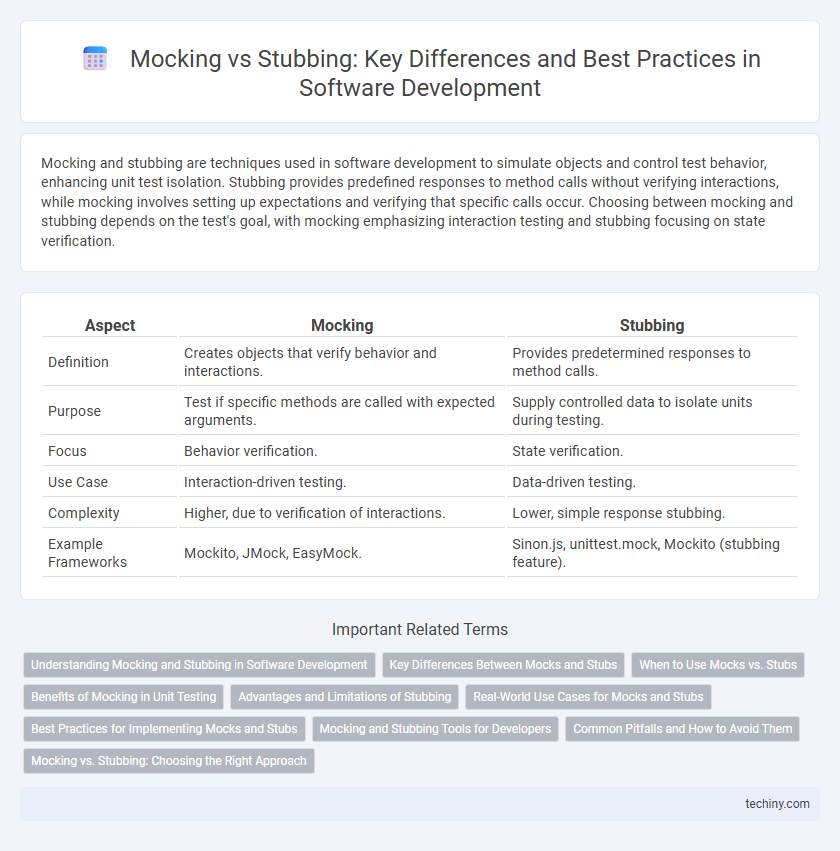Mocking and stubbing are techniques used in software development to simulate objects and control test behavior, enhancing unit test isolation. Stubbing provides predefined responses to method calls without verifying interactions, while mocking involves setting up expectations and verifying that specific calls occur. Choosing between mocking and stubbing depends on the test's goal, with mocking emphasizing interaction testing and stubbing focusing on state verification.
Table of Comparison
| Aspect | Mocking | Stubbing |
|---|---|---|
| Definition | Creates objects that verify behavior and interactions. | Provides predetermined responses to method calls. |
| Purpose | Test if specific methods are called with expected arguments. | Supply controlled data to isolate units during testing. |
| Focus | Behavior verification. | State verification. |
| Use Case | Interaction-driven testing. | Data-driven testing. |
| Complexity | Higher, due to verification of interactions. | Lower, simple response stubbing. |
| Example Frameworks | Mockito, JMock, EasyMock. | Sinon.js, unittest.mock, Mockito (stubbing feature). |
Understanding Mocking and Stubbing in Software Development
Mocking and stubbing are essential techniques in software development for isolating components during unit testing. Mocking involves creating objects that mimic the behavior of real dependencies, allowing verification of interactions and method calls, while stubbing provides predefined responses to method calls without tracking interaction details. Understanding the distinction between mocking's focus on behavior verification and stubbing's emphasis on state simulation enables developers to write more effective and maintainable tests.
Key Differences Between Mocks and Stubs
Mocks and stubs serve distinct roles in software testing; mocks simulate object behavior and verify interactions, while stubs provide predefined responses without tracking calls. Stubs help isolate code under test by supplying consistent data, whereas mocks validate that certain methods were called with expected arguments. Understanding these key differences improves test accuracy and maintainability in test-driven development.
When to Use Mocks vs. Stubs
Mocks are ideal for verifying interactions and behavior between components, especially in unit tests where the focus is on ensuring specific method calls occur with expected arguments. Stubs are best used for providing predetermined responses to method calls, allowing tests to isolate the unit under test from external dependencies and control the test environment. Choosing mocks is effective when testing side effects and communication, while stubs are suited for simulating controlled return values and simplifying complex dependencies.
Benefits of Mocking in Unit Testing
Mocking in unit testing enables precise control over complex dependencies, allowing developers to simulate interactions and responses without relying on actual implementations. This approach improves test isolation, leading to faster execution and easier identification of defects by focusing solely on the unit under test. Furthermore, mocks provide detailed verification of method calls, enhancing test accuracy and reliability in software development.
Advantages and Limitations of Stubbing
Stubbing in software development offers the advantage of simplicity and speed by providing predefined responses to function calls, enabling isolated testing of components without relying on complex dependencies. Limitations of stubbing include its inability to verify interactions or behavior beyond returned data, which can lead to less comprehensive test coverage compared to mocking. Stubs are best suited for situations where the focus is on input/output validation rather than interaction verification.
Real-World Use Cases for Mocks and Stubs
Mocks are ideal for verifying interactions in unit tests where the behavior of external dependencies must be simulated precisely, such as ensuring a payment gateway API call is made with correct parameters. Stubs provide predefined responses without asserting interactions, useful in scenarios like return values from a database query during front-end component testing. Real-world software development often uses mocks to test side effects and stubs to isolate code by replacing complex dependencies with fixed outputs.
Best Practices for Implementing Mocks and Stubs
Effective use of mocks and stubs enhances software testing by isolating components and simulating dependencies. Best practices include defining clear behavior expectations for mocks, returning consistent test data from stubs, and avoiding overuse to maintain test reliability and clarity. Prioritizing readability and maintainability ensures that test doubles provide meaningful and stable test outcomes in complex development environments.
Mocking and Stubbing Tools for Developers
Mocking and stubbing tools such as Mockito, Jest, and Sinon.js enable developers to simulate object behavior and isolate components during unit testing, improving test reliability and speed. These frameworks provide APIs to define expectations, control returns, and verify interactions, enhancing code maintainability and reducing dependencies on external systems. Effective use of mocking and stubbing tools accelerates development cycles by facilitating easier debugging and precise validation of software functionality.
Common Pitfalls and How to Avoid Them
Mocking and stubbing often lead to pitfalls such as over-specification and brittle tests that break with minor implementation changes. Avoid these issues by focusing on behavior verification rather than implementation details and ensuring test doubles only cover necessary interactions. Leveraging clear test boundaries and maintaining consistent test data improves reliability and reduces maintenance overhead in unit testing.
Mocking vs. Stubbing: Choosing the Right Approach
Mocking and stubbing are essential techniques in software testing, each serving distinct purposes: mocks verify behavior by asserting method calls, while stubs provide predetermined responses to method invocations. Choosing the right approach depends on the test objectives--use mocking to validate interactions and stubbing to isolate code by simulating dependencies. Effective use of mocking frameworks like Mockito or JMock can enhance test reliability and maintainability by clearly defining expected behaviors and return values.
Mocking vs Stubbing Infographic

 techiny.com
techiny.com